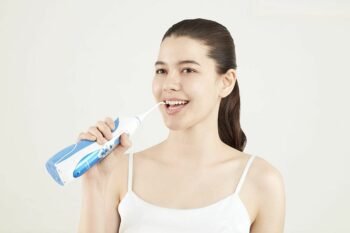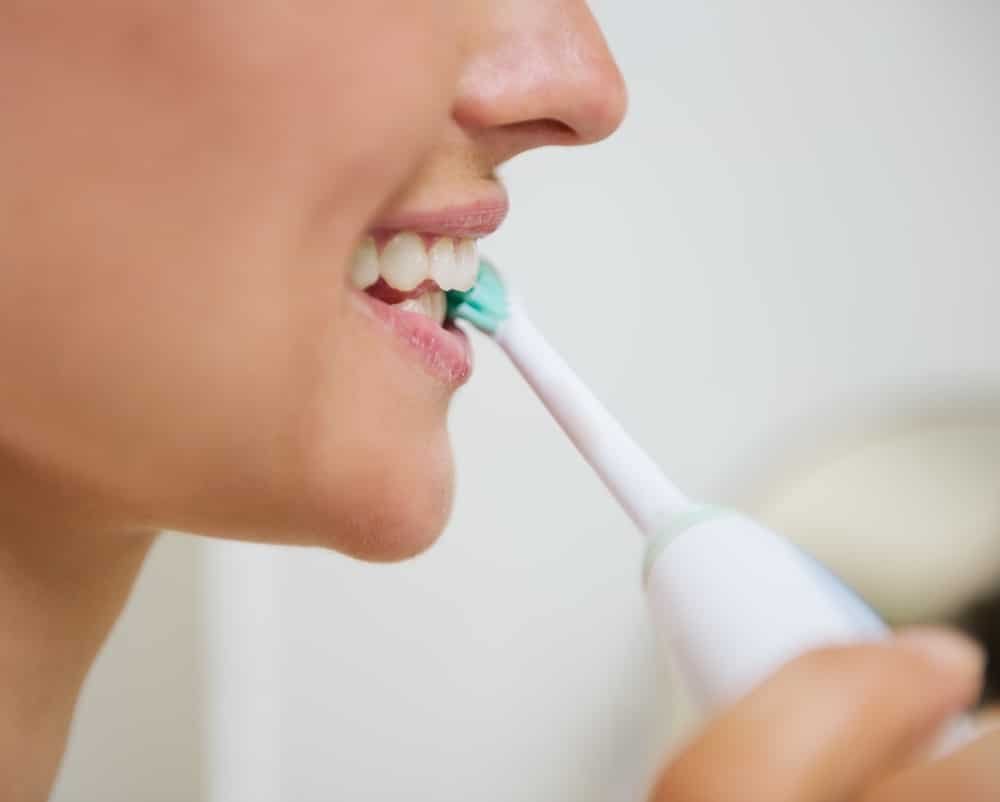There are many ways to care for your oral health, aside from seeing a dental hygienist or taking regular dentists’ visits. In this article, we’ve provided some ways to care for your teeth and oral cavity in the comfort of your home.
You can only experience all the benefits of using an electric toothbrush with the proper technique. Below are the correct ways on how to use an electric toothbrush every day.
How to Use Your Electric Toothbrush: 5 Steps
You may find that using an electric toothbrush very similar to tooth brushing with manual toothbrushes, and that’s because it is! But due to the movement of your electric toothbrush, maintaining your dental health couldn’t be easier. Let’s get started!
Step 1: Lubricate Toothbrush and Apply Toothpaste
Apply a pea-sized amount of fluoride toothpaste to your brush head. Do your research on the correct toothpaste to use, as the right one will prevent tooth decay and the buildup of plaque.
Step 2: Insert Brush at a 45-Degree Angle
Hold the brush at a 45-degree angle with a small amount of pressure, allowing the toothbrush to hold onto each brush for 3–5 seconds.
Step 3: Brush the Outsides of Your Teeth
Start from the outside of the back of your teeth and move it all the way around and the outside of your upper teeth until you’ve reached the other side of your oral cavity.
Dentists recommend you divide your mouth into 6 sections. 20 seconds should be allotted for each section. Tilting your toothbrush at 45-degree angle helps to remove the food debris stuck in the teeth. #teeth #TuesdayMotivation #Dentist #toothbrush #fooddebris #OralHealth pic.twitter.com/eDxvOx9hFw
— GROUP PHARMA (@group_pharma) November 20, 2018
Step 4: Brush the Outsides of Your Teeth
After you’ve done that, brush the teeth from the back left to the back right, but on the inside. Move the brush down to the lower teeth and repeat this process, starting at the back right again. Don’t forget to brush your tongue.
Step 5: Rinse
Rinse your mouth thoroughly with cold water to remove toothpaste and food particles. Don’t forget to rinse the brush head of your electric toothbrush as well. You can also check the charge level indicator lights on your toothbrush to see when it’s ready for the next charge.
How to Brush if You Have Braces
Begin by removing any rubber bands and rinse them before re-applying to your braces. Next, add toothpaste to your toothbrush and clean around the braces—including under the pins and around the wires. Most importantly, brush the wires, as this is where food particles can accumulate.
Continue brushing your mouth as you normally would, beginning at the bottom, spending around two minutes in total to prevent a bacteria build-up. Then, gently brush your tongue and spit out any toothpaste. Rinse your mouth with water, ensuring that you’ve removed any remaining toothpaste from your mouth.
Tips for Cleaning Your Teeth
 With electric toothbrushes, the most common mistake is that people guide the brush around too much. To give each tooth a thorough clean, you should give each tooth, as well as your tongue, gums, and the roof of your mouth, the same amount of care and attention.
With electric toothbrushes, the most common mistake is that people guide the brush around too much. To give each tooth a thorough clean, you should give each tooth, as well as your tongue, gums, and the roof of your mouth, the same amount of care and attention.
After brushing, floss afterwards using a water flosser or a regular floss. This process is important because a toothbrush can’t penetrate deep enough through stuck-on plaque. Best of all, proper flossing can reach surfaces behind the teeth that your electric toothbrush can’t always reach.
Furthermore, it might be a common misconception to use mouthwash immediately after brushing. Doing so can remove fluoride from your mouth, which means that your teeth won’t be as strong.
How Often Should You Brush Your Teeth?
Now that you know how to brush your teeth properly, it’s time to consider how often you should brush. Spend two minutes twice a day—in the morning and at night. Fortunately, most electric toothbrushes have timers, so you know how long to brush your teeth without calculating the time yourself.
Signs You’re Brushing Your Teeth Wrong
There are several ways to recognise if you’re brushing your teeth with a poor or unhealthy technique. Take a look at the signs below to see if you’re not brushing correctly.
Frayed Toothbrush
One of the most popular signs is a frayed brush head. When you brush too hard over time, the bristles on the toothbrush head will begin to fan out. This can typically happen when the toothbrush gets old, but it can also happen if you’re pressing too hard on your teeth.
Tooth Sensitivity
It’s not uncommon to have sensitive teeth, but one of the reasons could be caused by brushing incorrectly. Enamel protects your teeth’ surface, but when you press too hard on your teeth, this can brush away the enamel. When this happens, you’re exposing the surfaces of your teeth to food particles and cold air. In fact, teeth’ roots have many nerves, which can become extremely sensitive—especially when exposed.
View this post on Instagram
Reduced Brightness
If you’ve noticed that your smile looks duller, it could be because you’re losing enamel on the surfaces of your teeth by brushing too hard. Or you could be brushing too much.
The Benefits of an Electric Toothbrush
You know the importance of brushing teeth regularly and effectively, but the toothbrush you use can greatly impact your oral health. There are so many benefits to using electric toothbrushes, especially compared to manual toothbrushes. Let’s take a look at some of the main benefits.
Improved Cleaning
 Compared to a manual toothbrush, an electric toothbrush provides an exceptional clean to keep your tongue, teeth, and gums healthy. They’re also much more effective at cleaning your teeth than a manual toothbrush because they’re specially designed to remove plaque from around the teeth.
Compared to a manual toothbrush, an electric toothbrush provides an exceptional clean to keep your tongue, teeth, and gums healthy. They’re also much more effective at cleaning your teeth than a manual toothbrush because they’re specially designed to remove plaque from around the teeth.
Best of all, electric toothbrushes can reach awkward places in your mouth, such as the back molars. As a result, electric toothbrushes can decrease your risk of tooth decay, gum disease and bad breath.
Gentle on the Gum Line
When you use an electric toothbrush properly, it won’t hurt your gums. In fact, this type of toothbrush is kind and gentle on the gums to prevent any irreversible damage, such as receding gums and tooth enamel. Some electric toothbrushes come with pressure sensors that flicker when you apply too much pressure.
Encourages a Better Brushing Technique
Sometimes we can brush our teeth way too hard, but unless you’re feeling physical discomfort, you won’t always know that you’re using an incorrect brushing technique.
Fortunately, many electric toothbrushes light up when you’re pressing down too hard. And the major significance of this is to reduce injury to your gum line and not remove the enamel.
Easier Way to Brush Your Teeth
You can use an electric toothbrush even if you have joint or muscular pain since they don’t require much control. Simply switch on the toothbrush and guide the brush to different teeth and areas around your mouth.
You won’t need to use any other movement as the bristles will move. If you don’t have the ability to move freely, an electric toothbrush can help with plaque buildup without putting in much effort.
Extra Features
Typically designed with an alert of some sort, an electric toothbrush is great for people who don’t brush their teeth long enough. Depending on the toothbrush model you purchase, you can receive one that comes with a timer to alert you when you’ve brushed your teeth every 30 seconds.
And many smart electric toothbrushes come with an app, so you can see what action you’ve taken and even receive tips on better oral hygiene. For some people, having an app where you can see your progress encourages you to brush your teeth regularly.
View this post on Instagram
Do You Have Any Tips on Using a Toothbrush?
Reduce the buildup of bacteria in your mouth by investing in a high-quality toothbrush. There are many things you can do to improve your dental health.
Do you have any tips on how to use an electric toothbrush and other methods for improving oral hygiene? Share your thoughts in the comments below.
Additional Resources
Amy is a U.K.-based writer and editor with a penchant for helping consumers find the best home products for their needs, as well as providing easily digestible guides for living better at home. Her dedication to her work means she can usually be found elbow-deep in research or hunting down samples of the latest and greatest on behalf of her readers.
An avid DIYer herself, Amy’s passion lies in teaching others how they too can achieve their dream homes by tackling some of those pesky projects themselves! Whether it’s building furniture from scratch or turning an old dresser into a coffee table, Amy is always happy to share what she knows about making your house feel like home without spending a fortune.

